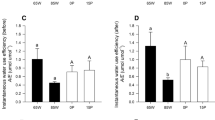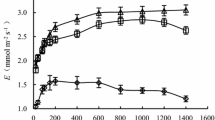Summary
Shoot water relations, summer gas exchange response and morphological development of western hemlock [Tsuga heterophylla (Raf.) Sarg.] and western red cedar (Thuja plicata Donn) seedlings were monitored over the first growing season on a coastal reforestation site in British Columbia. In March, osmotic potential (ψs) at saturation [ψs(sat)] was −1.98 MPa and turgor loss point [ψs(tlp)] −2.38 MPa for western hemlock, while western red cedar had −1.45 MPa ψs(sat) and −1.93 MPa ψs(tlp). Seasonally ψs increased through June and then decreased through September, with western hemlock −0.15 to −0.50 MPa lower than western red cedar. Maximum bulk modulus of elasticity (ɛmax) for western hemlock was 29.3 MPa in March, decreased to 15.0 MPa in June and increased to 25.0 MPa from July through September, while western red cedar ɛmax was 10.6 MPa in March and around 8.0 MPa thereafter. Utilized turgor (T util) for western hemlock was <40% from March through May, 69 to 78% from June through August and 96% in September, while western red cedar T util was 68 to 73% during March and April, 84 to 96% from May through August and 100% in September. Maximum CO2 assimilation rate (A) of western red cedar was more than double western hemlock, and for both species A declined in a linear fashion with increasing vapour pressure deficit (D). Maximum foliage conductance (g wv) declined in a concave manner as D increased in both species, with western red cedar values 50 to 67% greater than western hemlock. Maximum daily g wv declined in a concave manner as predawn shoot water potential (ψpd) decreased, with maximum daily g wv 1.8 to 3.6 times greater in western red cedar than western hemlock, when ψpd was −0.25 and −1.4 MPa, respectively. Western red cedar, compared to western hemlock, had a greater increase in A as g wv increased. Eight months after planting, western red cedar seedlings had twice the root growth, measured as root dry weight and root number, of western hemlock.
Similar content being viewed by others
References
Abrams MD (1988) Sources of variation in osmotic potentials with special reference to North American tree species. For Sci 34: 1030–1046
Bannister P (1976) Introduction to physiological plant ecology. Blackwell, London
Bowman WD, Roberts SW (1985) Seasonal changes in tissue elasticity in chaparral shrubs. Physiol Plant 65: 233–236
Chambers JL, Hinckley TM, Cox GS, Metcalf CL, Aslin RG (1985) Boundary-line analysis and models of leaf conductance for four oak-hickory forest species. For Sci 31: 437–450
Cheung YNS, Tyree MT, Dainty J (1975) Water relation parameters on single leaves obtained in a pressure bomb and some ecological interpretations. Can J Bot 53: 1342–1346
Colombo SJ (1987) Changes in osmotic potential, cell elasticity and turgor relationships of second-year black spruce container seedlings. Can J For Res 7: 365–369
Davis SD, Mooney HA (1986) Tissue water relations of four co-occurring chaparral shrubs. Oecologia 70: 527–535
Grieu P, Guehl JM, Aussenac G (1988) The effects of soil and atmospheric drought on photosynthesis and stomatal control of gas exchange in three coniferous species. Physiol Plant 73: 97–104
Grossnickle SC (1988) Planting stress in newly planted jack pine and white spruce. 2. Changes in tissue water potential components. Tree Physiol 4: 85–97
Grossnickle SC (1989) Shoot phenology and water relations of Picea glauca. Can J For Res 19: 1287–1290
Grossnickle SC, Reid CPP (1984) Water relations of Engelmann spruce seedlings on a high-elevation mine site: an example of how reclamation techniques can alter microclimate and edaphic conditions. Reclam Reveg Res 3: 199–221
Grossnickle SC, Russell JH (1991) Gas exchange processes of yellowcedar [Chamaecyparis nootkatensis (D. Don) Spach] in response to environmental variables. Can J Bot 69: 2684–2691
Grossnickle SC, Arnott JT, Major JE, Tschaplinski TJ (1991a) Influence of dormancy induction treatments on western hemlock seedlings. 1) Seedling development and stock quality assessment. Can J For Res 21:164–174
Grossnickle SC, Arnott JT, Major JE (1991b) Influence of dormancy induction treatments on western hemlock seedlings. 2) Physiological and morphological response during the first growing season a reforestation site. Can J For Res 21: 175 -185
Hinckley TM, Lassoie JP, Running SW (1978) Temporal and spatial variations in the water status of forest trees. For Sci Monogr No. 20
Hinckley TM, Duhme F, Hinckley AR, Richter H (1980) Water relations of drought hardy shrubs: osmotic potential and stomatal reactivity. Plant Cell Environ 3: 131–140
Jackson PA, Spomer GG (1979) Biophysical adaptations of four western conifers to habitat water conditions. Bot Gaz (Chicago) 140: 428–432
Jarvis PG (1976) The interpretation of the variations in leaf water potential and stomatal conductance found in canopies in the field. Philos Trans R Soc London Ser B 273: 593–610
Jenson CR, Henson IE (1990) Leaf water relations characteristics of Lupinus angustifolius and L. cosentinii. Oecologia 82: 114–121
Jones MM, Turner NC, Osmond CB (1981) Mechanisms of drought resistance. In: Paleg LG, Aspinall D (eds) Physiology and biochemistry of drought resistance. Academic Press, Australia, pp 15–37
Jungen JR (1985) Soils of southern Vancouver Island. B. C. Min Environ Tech Rep No 17
Kandiko RA, Timmis R, Worrall J (1980) Pressure-volume curves of shoots and roots of normal and drought conditioned western hemlock seedlings. Can J For Res 10: 10–16
Kikuta SB, Richter H (1986) Graphical evaluation and partitioning of turgor response to drought in leaves of durum wheat. Planta 168: 36–42
Klinka K, Feller MC (1984) Principles of tree species selection used in regenerating forest sites in southwestern British Columbia. For Chron 60: 77–85
Klinka K, Green RN, Courtin PJ, Nuszdorfer FC (1984) Site diagnosis, tree species selection, and slash burning guidelines of the Vancouver Forest Region, British Columbia, B. C. Min For Land Manage Rep No 25
Klinka K, Carter RE, Feller MC (1990) Cutting old-growth forests in British Columbia: ecological considerations for forest regeneration. Northwest Environ J 6: 221–242
Kramer PJ (1983) Water relations of plants. Academic Press, New York
Lassoie JP, Hinckley TM, Grier CC (1985) Coniferous forests of the Pacific Northwest. In: Chabot BF, Mooney HA (eds) Physiological ecology of North American plant communities. Chapman and Hall, New York, pp 127–161
Leverenz JW (1981) Photosynthesis and transpiration in large forest-grown Douglas-fir: diurnal variation. Can J Bot 59: 349–356
Livingston NJ, Black TA (1987a) Water stress and survival of conifer seedlings planted on a high elevation south-facing clear-cut. Can J For Res 17: 1115–1123
Livingston NJ, Black TA (1987b) Stomatal characteristics and transpiration of three species of conifer seedlings planted on a high elevation south-facing clear-cut. Can J For Res 17: 1273–1282
Ludlow MM (1989) Strategies of response to water stress. In: Kreeb KH, Richter H, Hinckley TM (eds) Structural and functional responses to environmental stresses. Academic Publishing, The Hague, pp 269–281
Meizner FC (1982) The effect of vapor pressure on stomatal control of gas exchange in Douglas-fir (Pseudotsuga menziesii) saplings. Oecologia 54: 236–246
Miller PC (1983) Comparison of water balance characteristics of plant species in “natural” versus modified ecosystems. In: Mooney HA, Gordon M (eds) Disturbance and ecosystems. Components of response. Springer, Berlin Heidelberg New York, pp 188–212
Nambiar EKS (1984) Significance of first-order lateral roots on the growth of young radiata pine seedlings under environmental stress. Aust For Res 14: 187–199
Reich PB, Hinckley TM (1989) Influence of pre-dawn water potential and soil-to-leaf hydraulic conductance on maximum daily leaf diffusive conductance in two oak species. Funct Ecol 3: 719–726
Ritchie GA, Hinckley TM (1975) The pressure chamber as a tool for ecological research. Adv Ecol Res 9: 165–254
Ritchie GA, Shula RG (1984) Seasonal changes of tissue-water relations in shoots and root systems of Douglas-fir seedlings. For Sci 30: 538–548
Roberts SW, Knoerr KK (1977) Components of water potential estimated from xylem pressure measurements in five tree species. Oecologia 28: 191–202
Roberts SW, Strain BR, Knoerr KK (1980) Seasonal patterns of leaf water relations in four co-occurring forest tree species: parameters from pressure-volume curves. Oecologia 46: 330–337
Roberts SW, Strain BR, Knoerr KK (1981) Seasonal variation of leaf tissue elasticity in four forest tree species. Physiol Plant 52: 245–250
Robichaux RH, Holsinger KE, Morse SR (1986) Turgor maintenance in Hawaiian Dubautia species: the role of variation in tissue osmotic and elastic properties. In: Givnish TJ (ed) On the economy of plant form and function. Cambridge University Press, New York, pp 353–380
Running SW (1976) Environmental control of leaf conductance in conifers. Can J For Res 6: 104–112
Sands R (1984) Transplanting stress in radiata pine. Aust For Res 14: 67–72
Sanford IR, Jarvis PG, (1986) Stomatal responses to humidity in selected conifers. Tree Physiol 2: 89–103
Schulte PJ, Hinckley TM (1985) A comparison of pressure-volume curve data analysis technique. J Exp Bot 36: 1590–1602
Schulze E-D, Hall AE (1982) Stomatal responses, water loss and CO2 assimilation rates of plants in contrasting environments. In: Lange OL, Nobel PS, Osmond CB, Ziegler H (eds) Physiological plant ecology II. Water relations and carbon assimilation. Springer, Berlin Heidelberg New York, pp 181–230
Steel RGD, Torrie JG (1980) Principles and procedures of statistics. 2nd edn. McGraw-Hill, New York
Tyree MT, Jarvis PG (1982) Water in tissues and cells. In: Lange OL, Nobel PS, Osmond CB, Ziegler H (eds) Physiological plant ecology II. Water relations and carbon assimilation. Springer, Berlin Heidelberg New York, pp 36–77
Watts WR, Neilson RE (1978) Photosynthesis in Sitka spruce [Picea sitchensis (Bong.) Carr]. IX. Measurement of stomatal conductance and 14CO2 uptake in controlled environments. J Appl Ecol 15: 245–255
Webb RA (1972) Use of boundary line in the analysis of biological data. J Hort Sci 97: 309–319
Author information
Authors and Affiliations
Rights and permissions
About this article
Cite this article
Grossnickle, S.C. Shoot water relations and gas exchange of western hemlock and western red cedar seedlings during establishment on a reforestation site. Trees 7, 148–155 (1993). https://doi.org/10.1007/BF00199615
Received:
Accepted:
Issue Date:
DOI: https://doi.org/10.1007/BF00199615




